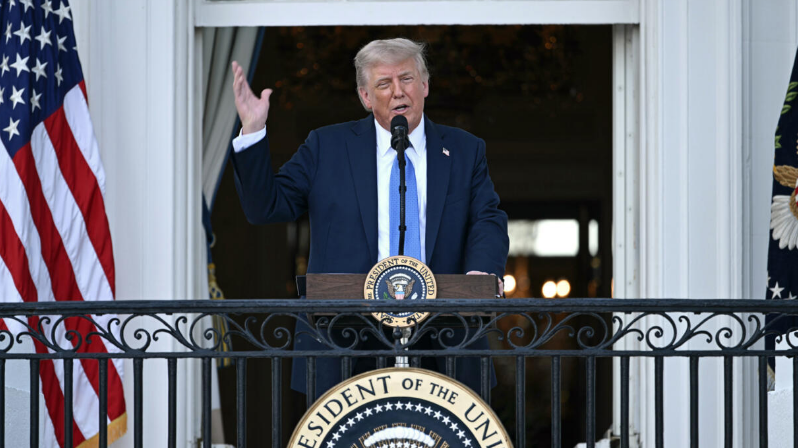
12 Nations Targeted in Trump’s Revised Travel Ban—What You Need to Know
Countries Under Trump’s Travel Ban: The current restriction will go into effect on Monday, June 9 at 12:01 am, providing passengers and government organisations a short window of time to make adjustments.
Trump Travel Ban Countries List 2025 Explained: President Donald Trump issued a new travel ban Wednesday, limiting entry into the United States from 12 nations and placing visa restrictions on seven others, over five months into his second term. The order aims to restrict what Trump has seen as a potential increase in immigration and resurrects his immigration agenda, which he had fought for during his first term.
The current restriction will go into effect on Monday, June 9 at 12:01 am, providing passengers and government organisations a short window of time to make adjustments.
What is a travel ban?
A federal regulation that restricts or forbids citizens of particular nations from entering the United States is known as a travel ban. From complete entry prohibitions to restricted suspensions of particular visa categories, the limitations can take several forms.
Trump’s most recent declaration is a return to his first-term travel bans from a number of nations. This updated list re-includes five of the impacted nations in that order.
What prompted the new ban?
Days after a tragic incident in Boulder, Colorado, an Egyptian national purportedly carried that out, the restriction was imposed. President Trump used the assault as a reminder of the dangers posed by people who overstay visas or who originate from countries with lax screening procedures, even though the ban does not include Egypt.
Which countries are affected?
The directive separates countries into two groups: those with restricted visa requirements and those with a total travel prohibition. Most of them are found in Latin America, the Middle East, and Africa.
Why were these countries selected?
The Trump administration offered three main reasons:
Lack of document security and screening capabilities: Afghanistan, Libya, Eritrea, Somalia, Sudan, Yemen, and Venezuela were among the nations mentioned for having untrustworthy officials in charge of passport issuance and foreign travel screening.
High visa overstay rates: Due to the high number of citizens who overstayed their visas in the United States, countries such as Burundi, Laos, Sierra Leone, Togo, Haiti, Burundi, Chad, Republic of Congo, Equatorial Guinea, Myanmar, and Turkmenistan were added.
Links to terrorism or state-sponsored terror: Iran, Afghanistan, Somalia, Libya, Cuba, and Sudan were among the nations that were marked for allegedly supporting or participating in terrorism.
What are the exceptions to the travel ban?
According to the White House order, green card holders who have a path to US citizenship are excluded from the restriction. Individuals who are dual citizens of the United States and a prohibited nation are likewise exempt. The decree further said that those applying for visas through close family members of US residents would not be impacted.
Athletes and coaches travelling for athletic events, as well as their families, will still be permitted entry into the United States because the country is hosting the Summer Olympics in Los Angeles in 2028 and the World Cup in 2026.
Additionally, refugees who have previously received asylum are exempt. Those Afghans who had sided with the United States during the protracted conflict that followed the September 11, 2001 terrorist attacks are also exempt.
Lastly, Iranians who are escaping religious persecution are also protected from the prohibition, especially those who belong to minority groups like Christians.
How is this different from the 2017 travel ban?
Shortly after becoming office, President Trump issued an executive order in 2017 that prohibited travel from seven nations with a large Muslim population. This order, sometimes referred to as the “Muslim ban,” has led to nationwide protests, court challenges, and airport mayhem. The prohibition underwent several revisions over time before the Supreme Court upheld it in 2018.
This current proclamation, in contrast to the 2017 ban, includes several specific exemptions and offers a short window before execution.
Timeline: Trump-Era travel bans (2017–2020)
Jan 27, 2017: The first travel prohibition was implemented. For ninety days, citizens of Iran, Iraq, Libya, Somalia, Sudan, Syria, and Yemen were prohibited from entering the United States.
Feb 3, 2017: A federal judge blocked the ban in Washington v. Trump.
Mar 6, 2017: The Trump administration introduced a second travel ban, removing Iraq from the list. The ban also exempted those with an existing green card or valid visa.
Mar 15, 2017: Two federal judges blocked core provisions of the ban, ruling that the most important section — banning travel from half a dozen countries — could not be enforced.
Sept 24, 2017: Third travel ban was introduced. Entry was barred for most citizens of Chad, Iran, Libya, North Korea, Somalia, Syria, Venezuela and Yemen. Iranian nationals with valid student and exchange visitor visas were allowed to enter.
Dec 4, 2017: The Supreme Court allowed the third ban to take effect while legal challenges continued.
Apr 10, 2018: Travel restrictions on Chad were removed after the country agreed with the administration’s security concerns.
June 26, 2018: The Supreme Court ruled 5-4 to uphold the third travel ban, saying the president has authority over national security concerns relating to immigration.
Jan 31, 2020: Fourth travel ban introduced. Immigrants from Eritrea, Kyrgyzstan, Myanmar, Nigeria, Sudan and Tanzania were barred from entering the US, but tourists and others entering on a temporary basis were not.
Jan 20, 2021: Upon taking office, President Biden revoked all of Trump’s travel bans.


